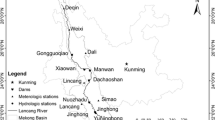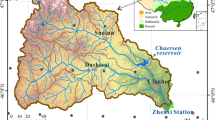Abstract
The objective of this study is to investigate the changes in the river flow regime under the influence of dam construction and climatic variability and disaggregate their individual effects. Daily discharge, temperature, and precipitation data were collected from Qaranqo River basin in East Azerbaijan (Iran) for the period of 1971–2017. To disaggregate the effects of climatic variability and dam construction, daily river discharge data after dam construction were simulated using an Artificial Neural Network (ANN). Then, with the use of Indicators of Hydrologic Alteration (IHA) and annual indexes, river flow regime changes were examined. Results showed that monthly flows in all months except for July, August, and September, decreased. Also, annual maximum flows (except for a maximum of 1 day) decreased and minimum flows (except for a minimum of 1 day) increased. The Julian dates of minimum and maximum flows had also preceded, in which both dam construction and climatic variability were influential. Both dam construction and climatic variability were equally effective for monthly flows, extreme flows, and Julian dates of extreme flows. However, dam construction played a greater role in the changes of high and low pulses, and fall and rise of flow hydrograph. The two indexes of relative and absolute ranges of variation of intra-annual parameters had decreased, while the non-uniformity coefficient, concentration degree, complete accommodation coefficient, and Richards-Baker index had increased, which were mainly affected by climatic variability. In the Environmental Flow Components (EFC) in the group of low monthly flows in most months, there was little difference between observed data and simulated data, which indicated the role of climatic variability in the river flow regime. By contrast, there was a significant difference in peak, duration, and time of large and small floods, which indicated the role of the dam construction in these components. Climate variability had the most role in changes of monthly low flows, extreme low flows, and high flows of river flow regime, while in small and large floods, the role of dam construction was significant. It can be concluded that the effect of climatic variability on flow regime in the Qaranqo River basin, was greater than the effect of dam construction.













Similar content being viewed by others
Availability of Data and Materials
All data, models, or code that support the findings of this study are available from the corresponding author upon reasonable request.
References
American Society of Civil Engineers (ASCE) (2000) Task committee on application of artificial neural networks in hydrology, artificial neural networks in hydrology. I: Preliminary concepts. J Hydrol Eng 5(2):115–123
Ashofteh P-S, Bozorg-Haddad O, Loáiciga HA, Mariño MA (2016) Evaluation of climate variability and human activities impacts on streamflow at the basin-scale. J Irrig Drain Eng 142(8). https://doi.org/10.1061/(ASCE)IR.1943-4774.0001038
Ashraf FB, Haghighi AT, Marttila H, Kløve B (2016) Assessing impacts of climate change and river regulation on flow regimes in cold climate: a study of a pristine and a regulated river in the sub-arctic setting of Northern Europe. J Hydrol 542:410–422
Clausen B, Biggs BJF (2000) Flow variables for ecological studies in temperate streams: Groupings based on covariance. J Hydrol 237(3–4):184–197
Cui T, Tian F, Yang T, Wen J, Khan MYA (2020) Development of a comprehensive framework for assessing the impacts of climate change and dam construction on flow regimes. J Hydrol 590:125358
do Vasco AN, Netto AOA, da Silva MG (2018) The influence of dams on ecohydrological conditions in the São Francisco River Basin, Brazil. Ecohydrol Hydrobiol 19(4):556–565
Gao B, Yang D, Yang H (2013) Impact of the Three Gorges Dam on flow regime in the middle and lower Yangtze River. Quatern Int 304:43–50
Gierszewski PJ, Habel M, Szmańda J, Luc M (2019) Evaluating effects of dam operation on flow regimes and riverbed adaptation to those changes. Sci Total Environ 710:136202. https://doi.org/10.1016/j.scitotenv.2019.136202
Lee A, Cho S, Kang DK, Kim S (2014) Analysis of the effect of climate change on the Nakdong river stream flow using indicators of hydrological alteration. J Hydro-Environ Res 8(3):234–247
López-Ballesteros A, Senent-Aparicio J, Martínez C, Pérez-Sánchez J (2020) Assessment of future hydrologic alteration due to climate change in the Aracthos River basin (NW Greece). Sci Total Environ 733:139299
Lu W, Lei H, Yang D, Tang L, Miao Q (2018) Quantifying the impacts of small dam construction on hydrological alterations in the Jiulong River Basin of Southeast China. J Hydrol 567:382–392. https://doi.org/10.1016/j.jhydrol.2018.10.034
Magilligan FJ, Nislow KH (2005) Changes in hydrologic regime by dams. Geomorphology 71(1–2):61–78
Peng Sh, Liu W, Wang W, Shao Q, Jiao X, Yu Zh, Xing W, Xu J, Zhang Z, Luo Y (2013) Estimating the effects of climatic variability and human activities on streamflow in the Hutuo River Basin, China. J Hydrol Eng 18(4):422–430
Pettit NE, Froend RH, Davies PM (2001) Identifying the natural flow regime and the relationship with riparin vegetation for two contrasting western Australian rives. Regul Rivers: Res Manage 17(3):201–215
Poff NL, Allan JD, Bain MB, Karr JR, Prestegaard KL, Richter BD, Sparks RE, Stromberg JC (1997) The natural flow regime. Bioscience 47(11):769–784
Remo JWF, Ickes B, Ryherd JK, Guida RJ, Therrell MD (2018) Assessing the impacts of dams and levees on the hydrologic record of the Middle and Lower Mississippi River, USA. Geomorphology. https://doi.org/10.1016/j.geomorph.2018.01.004
Richter BD, Baumgartner JV, Powell J, Braun DP (1996) A method for assessing hydrologic alteration within ecosystems. Conserv Biol 10(4):1163–1174
Richter B, Baumgartner J, Wigington R, Braun D (1997) How much water does a river need? Freshw Biol 37(1):231–249
Stuefer S, Yang D, Shiklomanov A (2011) Effect of streamflow regulation on mean annual discharge variability of the Yenisei River, Cold Region Hydrology in a Changing Climate (Proceedings of symposium H02 held during IUGG2011), Melbourne, Australia
Shakthi K, Sangam Sh, Mohanasundaram S, Salin K, Thanapon P (2021) Multiple drivers of hydrological alteration in the transboundary Srepok River Basin of the Lower Mekong Region. J Environ Manage 278:111524
The Nature Conservancy (2009) Indicators of Hydrologic Alteration Version 7.1 User's Manual, p 81. Available Online at: https://www.conservationgateway.org
Vu TT, Kiesel J, Guse B, Fohrer N (2019) Analysis of the occurrence, robustness and characteristics of abrupt changes in streamflow time series under future climate change. Clim Risk Manag 26:100198. https://doi.org/10.1016/j.crm.2019.100198
Wang W, Zhu Y, Dong S, Becker S, Chen Y (2019) Attribution of decreasing annual and autumn inflows to the Three Gorges Reservoir, Yangtze River: Climate variability, water consumption or upstream reservoir operation? J Hydrol. https://doi.org/10.1016/j.jhydrol.2019.124180
Wang W, Zhang Y, Tang Q (2020) Impact assessment of climate change and human activities on streamflow signatures in the Yellow River Basin using the Budyko hypothesis and derived differential equation. J Hydrol 591:125460
Yan Y, Yang Zh, Liu Q, Sun T (2010) Assessing effects of dam operation on flow regimes in the lower Yellow River. Procedia Environ Sci 2:507–516
Yang T, Zhang Q, Chen YD, Tao X, Xu C-Y, Chen X (2008) A spatial assessment of hydrologic alteration caused by dam construction in the middle and lower Yellow River, China. Hydrol Process 22(18):3829–3843
Yang T, Cui T, Xu C-Y, Ciais Ph, Shi P (2017) Assessing the impacts of climate change on flow regime alteration in an African river using a new IHA method. Global Planet Change. https://doi.org/10.1016/j.gloplacha.2017.07.006
Yang J, Yang YCE, Chang J, Zhang J, Yao J (2019) Impact of dam development and climate change on hydroecological conditions and natural hazard risk in the Mekong river basin. J Hydrol 579:124177. https://doi.org/10.1016/j.jhydrol.2019.124177
Zhang Y, Shao Q, Zhao T (2017) Comprehensive assessment of dam impacts on flow regimes with consideration of interannual variations. J Hydrol 552:447–459. https://doi.org/10.1016/j.jhydrol.2017.07.001
Zhang A, Zhang Ch, Fu G, Wang B, Bao Zh, Zheng H (2012) Assessments of impacts of climate change and human activities on runoff with SWAT for the Huifa river basin, Northeast China. Water Resour Manag 26(8):2199–2217
Funding
Not applicable.
Author information
Authors and Affiliations
Contributions
Leila Shakarami developed theory and performed computations. Parisa-Sadat Ashofteh verified analytical methods. Parisa-Sadat Ashofteh encouraged Leila Shakarami to investigate a specific aspect. Parisa-Sadat Ashofteh supervised findings of this work, and Vijay P. Singh helped supervise the project. All authors discussed results and contributed to final manuscript. Leila Shakarami wrote manuscript with support from Parisa-Sadat Ashofteh, and especially Vijay P. Singh. Parisa-Sadat Ashofteh conceived original idea.
Corresponding author
Ethics declarations
Conflict of Interest
None.
Additional information
Publisher's Note
Springer Nature remains neutral with regard to jurisdictional claims in published maps and institutional affiliations.
Rights and permissions
About this article
Cite this article
Shakarami, L., Ashofteh, PS. & Singh, V.P. Disaggregating the Effects of Climatic Variability and Dam Construction on River Flow Regime. Water Resour Manage 36, 3813–3838 (2022). https://doi.org/10.1007/s11269-022-03235-9
Received:
Accepted:
Published:
Issue Date:
DOI: https://doi.org/10.1007/s11269-022-03235-9




